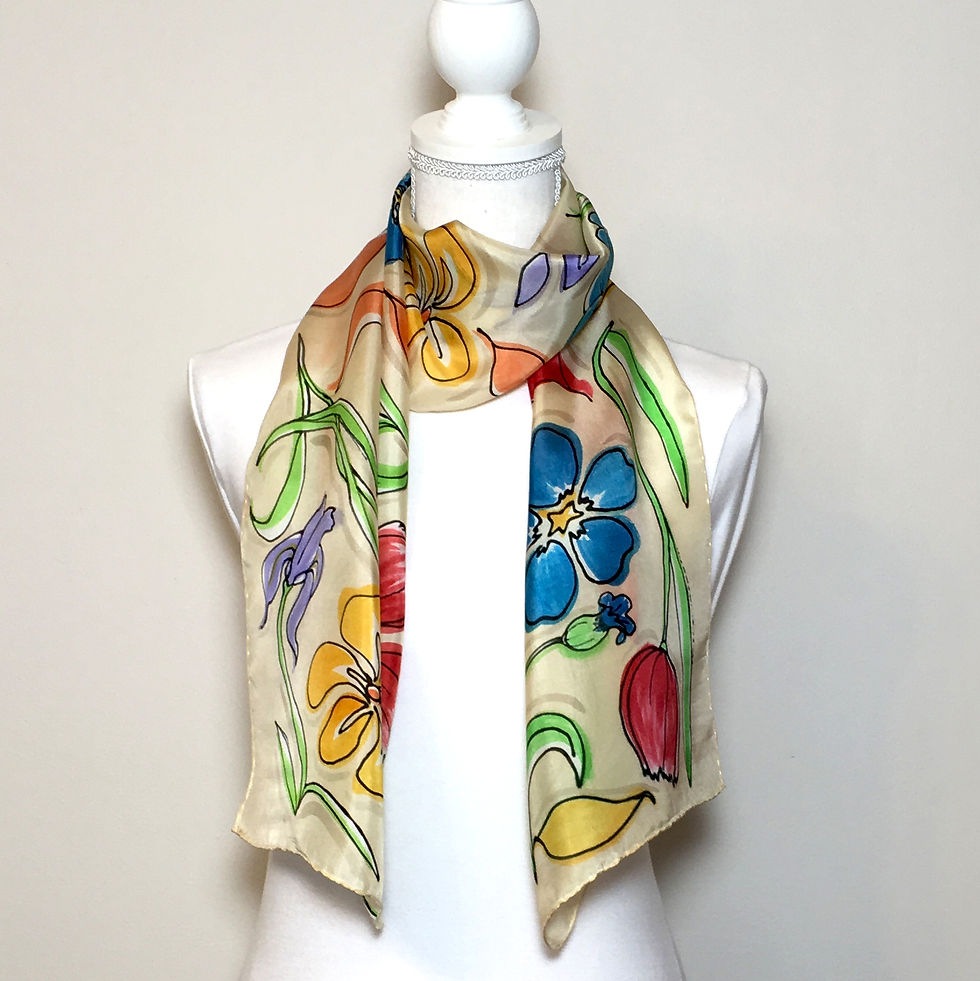No Resist Painting
- Carrie Wright

- Feb 20, 2020
- 3 min read
In preparation for the 10th annual Indiana Artisan Marketplace coming up the first weekend of April, I've been making a collection of scarves that celebrate color. They're quick to make, so allow a much lower price point, an important piece of inventory that was missing for me last year. I don't actually fully enjoy making them, though. I'm willing to do it because it gives a buyer an opportunity to purchase something hand-painted that is surprisingly inexpensive, but the process does not scratch my artistic itch! That's probably the biggest reason I don't try to do more art fairs throughout the year. Creating simply in order to produce inventory is not ideal for me.
Yesterday, I decided to start on this no resist piece as a change of pace to feed my soul. (For an education on resists, see my post about the basics of silk painting.) Working with no resist on the silk means dye is going to freely spread across the surface of the silk. The first time I tried this was on a 12mm satin, a silk that was just dense enough to give me a little more control over how far the dye spread. Think about it: the denser the weave, the faster the wet is absorbed, which means the dye stays a bit more localized to where it is placed. This technique requires you to not only pay close attention to how much liquid you're allowing on your brush, but also the direction of the grain lines with consideration to the shape of the motif. Dye runs faster along the straight of the grain, the warp, and tends to want to create a hard edge at the crossgrain, or the weft. You don't want to compensate for this by adding more and more dye to try to work across the grain as the motif will simply continue to run south and become distorted along the warp. To combat this, I take very small strokes with a barely wet zero brush. I sometimes even poke along at the silk, dabbing across the weft when necessary to get a nice rounded edge. Just takes practice!
In the middle photo above, you're looking at a wet edge on a 14"x72" flat crepe silk scarf. (Flat crepe has a sheen to its surface, unlike crepe de chine, and is lighter in weight and drape than satin/charmeuse.) I started this piece by brushing on a very pale silver color because I want the background to look like toned paper, not stark white.* I also wanted to add just a slight amount of color to the palette, so I sprayed water down the sides after the silver was applied in order to seamlessly work a hint of mauve at the edges into the silver middle ground. Again, just thinking of that background as a toned paper and trying to add some interest to the base.
In the first and third photos above, you can see my process. I added a rose color in some careful organic shapes near the end of the scarf before adding almond blossom floral elements. (I'm not sure I like that rose background I've got going, so that might get some work before I call this one finished.) I'm creating an underlay of a warm mid-tone gray to carefully sketch out each basic shape, allowing that to mostly dry, then adding detail strokes in black. I find using two colors of darks like this helps me get to more of an ink wash effect, which is what I'm after. I love the look of Sumi-e painting and am trying to capture a flavor of that with this piece. I've worked on this for about three hours now and hope to finish it today without ruining it.

*Having a layer of dye on the silk before beginning a no resist painting can help slow down the flow of the next layer of dye color. Having that base layer of pigment in the silk fiber will act as a minor barrier for you. It is by no means a resist, but when working on a piece this delicate, it is a small help in the process! Remember: tiny brush, very little dye, careful strokes. A piece like this will require you to slow all the way down to a crawl, so don't attempt it if you're feeling anxious or impatient for an end result!













For a bold fashion statement, the 8 Ball Bomber Jacket is an unbeatable choice. Its bomber design adds an extra layer of modern edge while preserving the jacket’s original cultural roots. Fashion lovers continue to embrace this piece for its versatility. See more at Stussy Jacket.